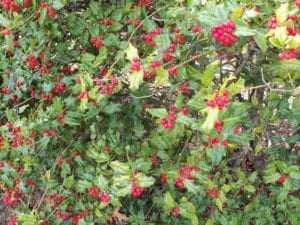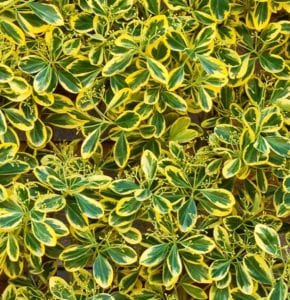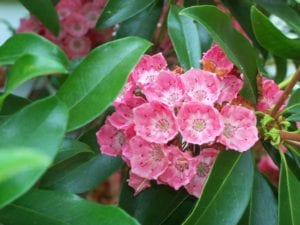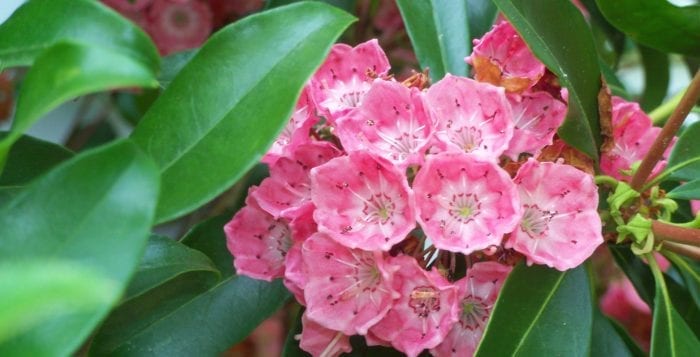By Ellen Barcel

Broadleaf evergreens are not conifers (which evolved about 300 million years ago), but flowering plants (which evolved about 125 million years ago). It’s just that broadleaf evergreens happen to keep their leaves throughout the winter and in many cases can be used the same way that conifers can — as a year-round privacy screen. Yes, eventually they will lose their leaves, but they will stay on the plant over winter and will present a beautiful, almost Christmas card, scene covered with snow.
Azaleas and rhododendrons immediately come to mind, especially in Long Island’s acidic soil. But, there are a number of other evergreen shrubs to consider.
Euonymus come in a wide variety of sizes and colors. Small cream-colored flowers will produce red berries in autumn on some varieties. Some are fast growers that reach an enormous size and need to be pruned back several times a year — unless you really want a massive shrub. The golden variety can revert to type (that is, have its leaves turn all green), resulting in a shrub that’s part golden and part green.

Some are considered invasive in Suffolk County, including Euonymus alatus (winged euonymus, also called burning bush due to its red leaves in autumn) and E. fortunei (winter creeper), and are on the Do Not Sell/Transfer list. I had one that had a branch root underneath a house shutter — how’s that for invasive? Since this shrub has a number of negatives, why plant it? Do so only if you find noninvasive varieties and are sure you have the room to grow it to its potential.
Holly is one of my favorite shrubs, although over time, they can reach the size of small specimen trees. Most varieties need at least one male plant (which does not produce red berries) in the area to pollinate the female shrubs. Even holly varieties that are self-fertile will produce more red berries with a male plant in the vicinity. Holly prefers an acidic soil, so is ideal for Long Island’s soil. Another plus is that they are fairly disease and insect resistant. Some varieties are even deer resistant. While a number of my shrubs has been munched on by deer, the holly have never been touched.

Mountain laurel (Kalmia latifolia), in the heather family, is native to North America. It blooms in May and June and is hardy in zones 4 to 9. This can be a very large shrub, maturing at 7 to 15 feet tall and easily about as wide. Do not plant this one in front of a window, unless you really want to block the view. However, it is a slow grower. It prefers full sun and, like rhodies, prefers an acidic soil (in a pH range of 4.5 to 5.5). The plant is toxic to humans and some animals — this is strictly an ornamental here. Its uniquely shaped flowers bloom in white to dark pink colors, all with purple markings.
Firethorn (Pyracantha) are thorny, evergreen shrubs in the Rosaceae family. They tend to be upright, rather than bushy shrubs, and due to the thorns should not be planted anywhere near walkways or pools. The plants can get to be quite tall, up to 12 feet at maturity. They present small white flowers in spring and summer that mature to either orange or yellow berries in autumn, which the birds love but are not edible for humans. They are hardy in zones 6 to 9. It’s an easy plant to grow and pretty much pest free. They grow in a wide variety of soil pH levels from acidic to alkaline. They grow well in shady areas and, an added bonus for those of you with clay soil, do well in sandy, loamy and even heavy (clay) soils. If it wasn’t for the thorns, this would be pretty much a perfect plant.
No plant is perfect for every location. Always read plant tags carefully to check for requirements and final size. You don’t want your home to have its windows blocked by giant shrubs or spend entirely too much time pruning them back.
Ellen Barcel is a freelance writer and master gardener. To reach Cornell Cooperative Extension and its Master Gardener program, call 631-727-7850.





